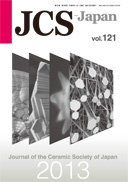Volume 119, Issue 1388
(April)
Displaying 1-15 of 15 articles from this issue
- |<
- <
- 1
- >
- >|
Special Articles: The 64th CerSJ Awards for Advancements in Ceramic Science and Technology: Review
-
2011Volume 119Issue 1388 Pages 255-260
Published: April 01, 2011
Released on J-STAGE: April 01, 2011
Download PDF (1715K) -
2011Volume 119Issue 1388 Pages 261-265
Published: April 01, 2011
Released on J-STAGE: April 01, 2011
Download PDF (1017K) -
2011Volume 119Issue 1388 Pages 266-270
Published: April 01, 2011
Released on J-STAGE: April 01, 2011
Download PDF (2638K)
Papers
-
2011Volume 119Issue 1388 Pages 271-276
Published: April 01, 2011
Released on J-STAGE: April 01, 2011
Download PDF (2636K) -
2011Volume 119Issue 1388 Pages 277-281
Published: April 01, 2011
Released on J-STAGE: April 01, 2011
Download PDF (1107K) -
2011Volume 119Issue 1388 Pages 282-284
Published: April 01, 2011
Released on J-STAGE: April 01, 2011
Download PDF (1284K) -
2011Volume 119Issue 1388 Pages 285-290
Published: April 01, 2011
Released on J-STAGE: April 01, 2011
Download PDF (1003K) -
2011Volume 119Issue 1388 Pages 291-294
Published: April 01, 2011
Released on J-STAGE: April 01, 2011
Download PDF (182K) -
2011Volume 119Issue 1388 Pages 295-302
Published: April 01, 2011
Released on J-STAGE: April 01, 2011
Download PDF (13138K) -
2011Volume 119Issue 1388 Pages 303-306
Published: April 01, 2011
Released on J-STAGE: April 01, 2011
Download PDF (2108K) -
2011Volume 119Issue 1388 Pages 307-309
Published: April 01, 2011
Released on J-STAGE: April 01, 2011
Download PDF (801K) -
2011Volume 119Issue 1388 Pages 310-313
Published: April 01, 2011
Released on J-STAGE: April 01, 2011
Download PDF (2152K) -
2011Volume 119Issue 1388 Pages 314-318
Published: April 01, 2011
Released on J-STAGE: April 01, 2011
Download PDF (1939K)
Technical report
-
2011Volume 119Issue 1388 Pages 319-321
Published: April 01, 2011
Released on J-STAGE: April 01, 2011
Download PDF (1390K)
Note
-
2011Volume 119Issue 1388 Pages 322-324
Published: April 01, 2011
Released on J-STAGE: April 01, 2011
Download PDF (498K)
- |<
- <
- 1
- >
- >|
